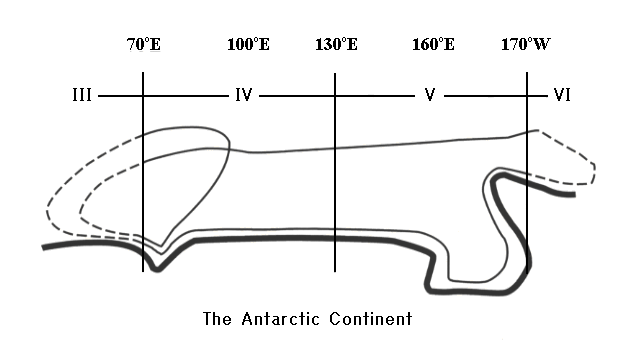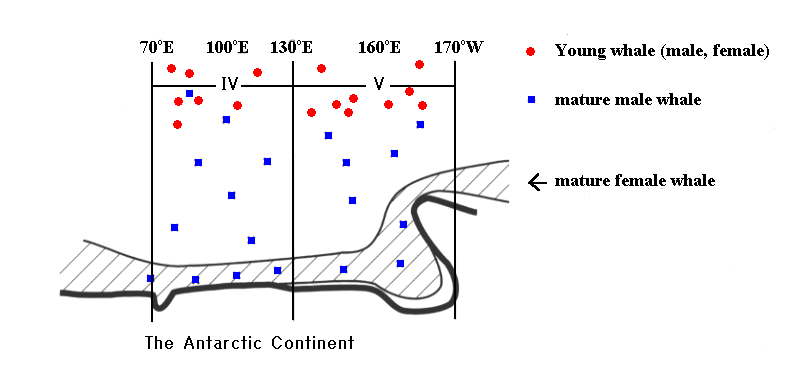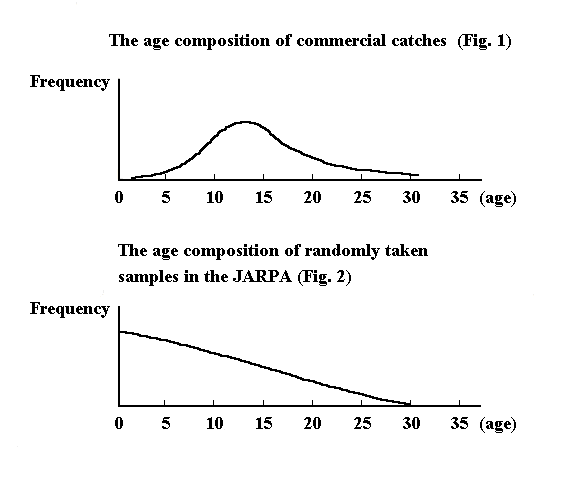
The Riches of the Sea,
Edited by the Fisheries Agency
As authorized by the Article VIII of the Convention (International Convention for the Regulation of Whaling), Japan has been conducting research on minke whales under Special Permit in the Antarctic (JARPA) every year since the 1987/88 research season. Objectives of the research include "estimation of biological parameters of minke whales" and "elucidation of the Antarctic ecosystem." These reasonably require a long-term continuous survey.
The Scientific Committee of the IWC reported that "members commented on the high quality of certain aspects of the work" (IWC 1994). In fact, since the beginning of the research, Japan has undertaken a number of practical modifications on the research plan in response to the recommendations made by the Scientific Committee (SC).
2 - NEED FOR SCIENTIFIC RESEARCH
Japan considers that safe management of the whale resources requires both non-lethal and lethal research. The population size can be obtained by a non-lethal method such as a sighting survey. The International Decade of Cetacean Research (IDCR) has been conducted since 1978 to estimate the stock abundance of whales. Based upon the data obtained through the IDCR cruises, the IWC Scientific Committee (IWC/SC) estimated the population size of the Southern Hemisphere minke whales to be 760,000 animals.
However, non-lethal research, by itself, cannot suffice for age-composition, stock-structure, chemical and pollution studies. These studies tells us whether the populations are increasing or not; how many stocks comprised the resource; and how the population dynamics change in response to external effect such as competition from other species and environmental changes.
The age-composition of a stock is determined through the analysis of ear plugs. Ear plugs are internal organs and cannot be obtained from any of the existing non-lethal methods. Also, in order to fully identify stock-structure, several stock-identification approaches have to be used such as isozyme, morphological, and pollutant analyses. While DNA studies could be conducted using biopsy samples, the other approaches require internal tissues.The chemical and biological study of whale samples in parallel with research on the environment is required to assess the environmental impact on whales Reproductive organs are necessary to understand the changes in reproduction rates caused by environmental changes. For ecological studies, research on the minke whale stomach contents is necessary.
Thus, it is abundantly clear that lethal research is very necessary for the safe management of the whale resources.
3 - FINDINGS
The JARPA is a 16-year program, designed to provide comprehensive results when it is completed. The program has, after its seventh year, found the following.
1) Clues were obtained to identify the stock-structure of Antarctic minke whales (The research suggests two stocks in the research area).
Before the JARPA, it was assumed that there were independent
stocks in Area IV and in Area V. As the research continues, it is
becoming clear that the stockstructure in the research area is more
complicated than previously thought. Based upon genetic analysis
with mtDNA and morphological analysis of the samples, it appears
that there is one stock distributed throughout Area IV and V and a
different stock in the western part of Area IV. This stock also seem
to be distributed in the adjacent area (Area III).

2) The evidence is accumulating for the segregation of Antarctic minke whales.
Mature males are distributed evenly from the pack-ice edge to
offshore. However, mature females form groups along the pack-ice
edge. In addition, it was found that young whales, both male and
female, have a tendency to be distributed offshore. However,
because it was also found that these segregations vary from year to
year, it is necessary to conduct further research.

3) Many young minke animals are found in the Antarctic.
Because commercial whaling operations focused their attention on
large animals, the majority of the commercial catches consisted of
mature animals of 10 to 15 years of age (Fig.1). In contrast, the
randomly-taken of the JARPA well represent the total population;
these samples show that population's age composition has its
peak in one-to-five-year-old animals and gradually decreases with
age (Fig.2). Thus the sampling survey, for the first time, found that
there are many younger animals in the minke resource and that the
population itself is quite healthy and robust. The hypothesis is that
the age distribution of minke whales is similar to that of the human
population pyramid. To test this, it is therefore necessary to take
samples from all age-groups.

4) It was found that there are dwarf minkes and larger so-called ordinary minkes in the Antarctic minke whale populations.
Little is known about dwarf minkes because they were not caught in the commercial whaling operations. As a result of sampling and analysis of the dwarf minkes in the JARPA, it was found that the dwarf minkes, which had been previously thought to be distributed in the medium latitude water, are actually distributed as far South as 62oS. The dwarf minkes are found to be distributed north of the ordinary forms. Genetically and morphologically, dwarf minkes are found to be closer to North Atlantic minke whales than to ordinary Antarctic minkes.
5) The biological energy now in the Antarctic Ocean is becoming clearer.
The analysis of the stomach contents of the samples shows that the Antarctic minke whales mainly feed on Euphausia superba; this comprises 94-100% of the weight of their entire food intake. The role of the Southern Hemisphere minke whales in the Antarctic Ocean ecosystem is becoming clearer.
6) Very little of chemical contaminants is detected in the Southern Hemisphere minke whales.
The analysis of the minke whale meat from the samples obtained through the JARPA detected very little organochlorine residues and heavy metal accumulation. The residue levels are lower than the Japanese government standard for acceptable residue levels of toxic substances in other animal and plant foods.
------------------------------------------------------------
total mercury 0.02ppm(0.4ppm for seafood)
TBTO Not detected.
Dieldrin Not detected. (0.2ppm for imported beef)
PCBs Not detected. (0.5ppm for meat and deep-sea fish)
DDTs Not detected. (0.2ppm For vegetables and crops
while 5ppm for imported beef)
------------------------------------------------------------
_